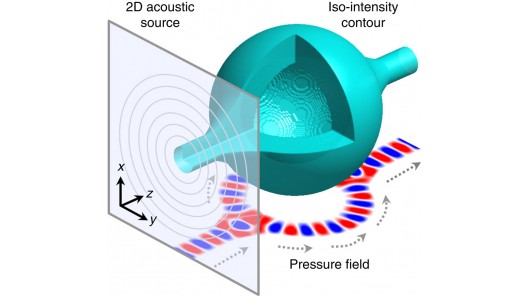
Using a technique that has possible applications in acoustic cloaking, sonic levitation, ultrasonic imaging, and particle manipulation, scientists at the University of California Berkeley claim to have produced a "bottle" beam of acoustic energy in open air that can precisely redirect sound waves. Able to bend these waves along set trajectories without the need for waveguides or other mechanical assistance, the bottle beam is also able to flow around objects in its path while maintaining its shape.
 Using a technique that has possible applications in acoustic cloaking, sonic levitation, ultrasonic imaging, and particle manipulation, scientists at the University of California Berkeley claim to have produced a "bottle" beam of acoustic energy in open air that can precisely redirect sound waves. Able to bend these waves along set trajectories without the need for waveguides or other mechanical assistance, the bottle beam is also able to flow around objects in its path while maintaining its shape.
Using a technique that has possible applications in acoustic cloaking, sonic levitation, ultrasonic imaging, and particle manipulation, scientists at the University of California Berkeley claim to have produced a "bottle" beam of acoustic energy in open air that can precisely redirect sound waves. Able to bend these waves along set trajectories without the need for waveguides or other mechanical assistance, the bottle beam is also able to flow around objects in its path while maintaining its shape.
Sound waves – like light waves – travel in straight lines, but can be bent through reflection, diffraction, or refraction. In the case of the Berkeley Lab experiments, the researchers bent sound waves using an array of acoustic transducers – effectively high-frequency loudspeakers – some 1.5 cm (0.6 in) in diameter, spaced 2.5 cm (0.98 in) apart and operating at a frequency of 10 kHz. This array was able to directly alter the phase and direction at which each sound wave was generated so that a defined set of pressure fields with distinct trajectories were created in the air.
As a result, the team claimed to have produced an acoustic bottle beam whose sound waves travel through the high pressure wall of its curved shell to flow around a zero pressure center. In this way, the sound waves are held together and are able to travel on in this fashion over some distance. The acoustic bottle beam is also uninfluenced by solid objects that are placed in its path, with the shape and characteristics of the sound waves reforming after flowing around the object.
"Our acoustic bottle beams open new avenues to applications in which there is a need to access hard-to-reach objects hidden behind obstacles, such as acoustic imaging and therapeutic ultrasound through inhomogeneous media," said Berkeley Lab researcher Tongcang Li. "We can also use an acoustic bottle as a cloaking device, re-routing sound waves around an object and then recovering them in their original form, making the object invisible to sonar detection."
As the high pressure exterior of the acoustic bottle also applies a dragging force to the surrounding air, no sound waves can pass through the zero pressure interior of the bottle thereby making it suitable for acoustic trapping. In this way, nanoparticles and similarly microscopic objects may be held in place with nothing more than sound wave pressure surrounding them.
Similarly, acoustic levitation, where sound waves are used to move and handle microscopically small objects, such as nanoparticles, microbes, or water droplets, may also be rendered possible by continued development of this research. The team also believes that their work may find use in the likes of 3D graphic printing and object manipulation by emulating recent standing wave experiments in that area.
"Our acoustic bottle beams can do the same thing but offer better stability, true 3D graphics, and more freedom of motion as our beam can propagate along a curved path," said co-researcher Xuefeng Zhu. "We can also levitate much larger 3D objects than can be lifted and manipulated with other acoustic levitation techniques."
By creating acoustic beam propagation along prescribed trajectories without the need for mechanical intervention, the team may also have offered significant advances in applications such as medical ultrasound imaging and therapeutic ultrasound, where the direction of beam travel is difficult to control through the body.
"Since the principle of adjusted phased arrays is well-established and now being used in ultrasound imaging, we can directly apply our acoustic bottle beam technique to current acoustic systems," said Peng Zhang, lead author of a paper that described this work. "Our technique offers a new degree of freedom for controlling the flow of acoustic energy at will."

 Previous page
Previous page Back to top
Back to top







